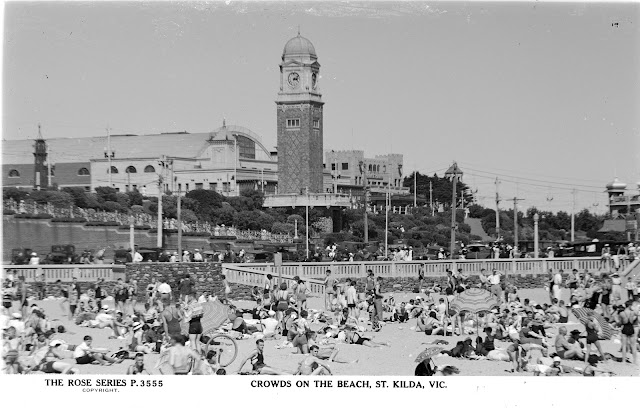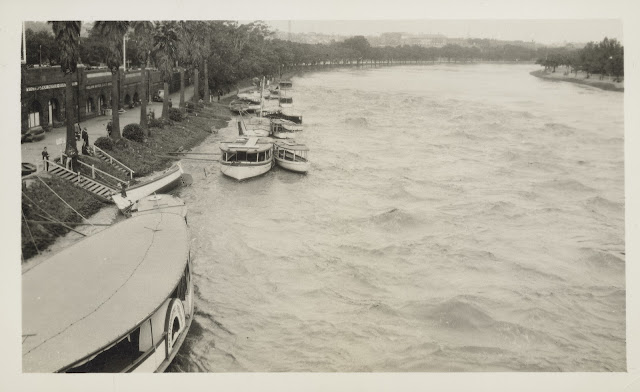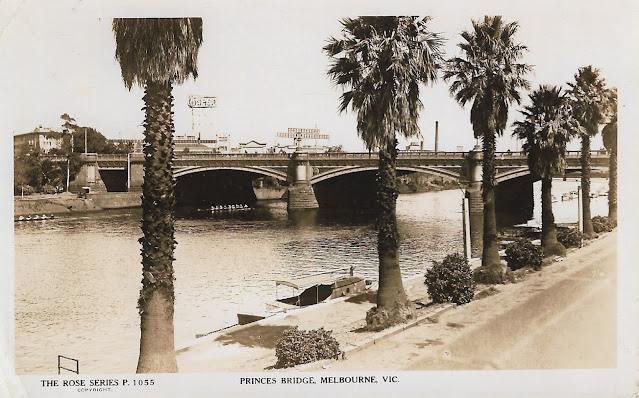In 1888 the new Princes bridge over the Yarra River was completed. It was designed by the firm of Jenkins, D'Ebro and Grainger - J.S. Jenkins, Charles D'Ebro and John Harry Grainger, the father of Percy Grainger, the musician
(1). The bridge required the Yarra Bank Road to the east to be realigned and the road was built up on top of vaults which were constructed in 1889/1890 and opened on to a walkway along the Yarra River. The new walkway was called Princes Walk and the vaults were known as Princes Walk Vaults
(2). In July 1913, the Melbourne City Council renamed this eastern portion of Yarra Bank Road, Batman Avenue
(3). The name was suggested by the Historical Society of Victoria to honour John Batman (1801-1839) the Melbourne pioneer.
Report of Melbourne City Council meeting, where the decision to use the name Princes Walk was made.
Princes Walk.
River Yarra at Princes Bridge, Melbourne. Photographer: Charles Rudd (1849-1901)
Around 1901, nine palm trees were planted along the Princes Walk. At this time Carlo Catani was responsible for the Yarra River improvement and beautification works. Carlo had prepared the plans for straightening and widening the Yarra and the entire project was carried out under his direction and supervision. He also designed Alexandra Avenue, which runs alongside the Yarra and which was officially opened on May 17, 1901. The Alexandra Gardens, across the Yarra River from Princes Walk, were also designed by Carlo, in conjunction with the curator, George Cooper. The fact that Carlo was intricately involved with these Yarra beautification works, suggests that he was responsible for the planting of these palm trees. This post looks at the history of the nine palms - the Princes Walk Palms - which Melburnians either loved or loathed.
The earliest photo I could find of the Princes Walk palm trees, c. 1904.
Yarra River and Princes Bridge. Photographer: Robert Scott.
State Library of Victoria http://handle.slv.vic.gov.au/10381/67461 SLV have this photo incorrectly dated as c. 1920.
Spectators on the north bank of the Yarra amongst the Princes Walk Palms, 1906.
Henley Regatta, Melbourne. Photographer: Robert Scott
The Princes Walk Palms grew to become part of Melbourne's skyline and formed part of the backdrop for many Henley on Yarra Regattas. The Henley on Yarra races commenced in 1903
(4), and spectators lined up on both sides of the Yarra to view the race. So popular was this regatta that in 1908, Carlo Catani and George Cooper laid out the Henley Lawn in the Alexandra Gardens.
Spectators amongst the Princes Walk Palms. I believe this photo was taken c. 1907.
Henley on the Yarra. Photographer: George Rose.
The Princes Walk Palms also appeared in many photos and postcards.
The Princes Walk Palms, c. 1908
River Yarra from Princes Bridge.
A view of the palms, Princes Bridge and the Ferry Alexandra, 1917.
Princes Bridge. Public Works Department photographer.
Aerial view of Melbourne, c. 1927/1928. The Princes Walk Palms are standing proud, on the left.
Russell Street and Collins Street, looking south across Princes Bridge. Photographer: Airspy
The Princes Walk Palms viewed from the south bank of the Yarra River, September 1929.
Princes Bridge, Melbourne.
The first report that I could find that some Melburnians were not entirely enamoured with these nine palms was in August 1933, when the artist, Arthur Streeton had an article published in The Argus. The article was about improving the City's gateway and he firstly commented on some on our grand bluestone buildings as Parliament House and the Victoria Barracks and he noted that all the bluestone came from the north of Melbourne and none from south of the Yarra. He continued with attention it is remarkable how many "broken tooth looking," useless rocks have been transported from the north to the south side of the Yarra. For many years many thousands of them have been used by landscape gardeners for "decoration" and other purposes between Domain road and Prince's Bridge, along St Kilda road. Streeton also disliked the forlorn row of nine palm trees north of the bridge waves rigged green heads against the motley of Flinders street architecture. The enormous bulk of their shabby skirts might have been dragged from the mud of the Yarra. His two suggestions for improving Melbourne gateway were the removal of the stones and rockeries and the removal of the nine tall palms - and all others like them--running eastward from the bridge, and the replacement of the palms with another row of Lombardy poplars (5).
Another letter writer agreed and hoped that if Mr Streeton's letter would help towards sounding the death knell of those terrible palms on the north bank of the Yarra, Melbourne should be eternally grateful (6).
1934 was a mixed year for the palms. In the February, The Herald, had a photograph of the palms with the caption - The Nine Palms of Princes Bridge, destined perhaps to rival "Under the Clocks" at Flinders Street station as a trysting place for Youth and Beauty (7). In the July the palm trees were featured in a view of Melbourne on stamps issued to celebrate Victoria's centenary (8).

The Yarra River and the Princes Walk Palms on the Centenary of Victoria stamps, issued July 1934.
Image: EBay.
In August 1934, Clare Lyle, Lady Lyle (9) wrote to the The Argus in support of the palms Nine stately palms, perhaps 30ft high, stand guard on the Yarra bank between Flinders street railway station and the river. Their uncommon beauty is remarkable. I know of no others like them. Report has it that they are to be destroyed. I cannot believe such a thing to be possible. There could be no excuse (10).
A letter, written by George Brown, in response took issue with Lady Lyle's description of the palms - "Their uncommon beauty is remarkable; I know of no others like them." To those viewing them daily such a description must cause surprise, and is very misleading to those at a distance. The palms Brahea Alífera, or "thread palm," have unsightly stems approximately 35ft. high, capped with few and half-starved leaves; forlorn objects which, having had their day and having fulfilled their purpose, must give place to things more in keeping with the position and changing conditions (11).
Mr Brown's letter brings up the issue of what sort of palms these were; he called the Brahea Alífera, or "thread palm. The Argus in July 1931 called them cotton palms (12). The Newcastle Morning Herald identified them as belonging to the Washingtonia genus (13). A friend of mine, experienced in municipal gardening, says they are the Washingtonia filifera palm. The palms may have been purchased from Cremorne nursery, in nearby in Richmond - they were reported to raise thousands of various palms every year of and for drawing-room and table decoration the tender varieties cannot be excelled, whilst the hardy specimens form excellent plants for the lawn or flower border (14).
It was in 1935 that the first rumblings were heard from the Melbourne City Council about the palms - The stately palms along the north bank of the Yarra near Prince's Bridge may be removed if a plan prepared by the curator of parks and gardens (Mr. J. T. Smith) is adopted. Mr. Smith admits that the palms have a strong sentimental value, particularly for artists who like to paint Melbourne from the opposite bank, but several members of the parks and gardens committee consider that they have a dirty, shabby appearance and should be replaced by more attractive trees. The estimated cost was £8,000 which also included regrading of the lawn and extending the path (15).
In 1936 there were the occasional letters in support of the palms from time to time civic reformers gaze sorrowfully at the nine palms on the Yarra bank near Princes Bridge, and cry aloud that they should be removed. But if eccentricity in man is tolerated to add a little to the gaiety of nations, why should eccentricity in Nature be condemned? Nature would be dull if she reduced everything to a dead level of uniformity. She has her more whimsical moods, and the Nine Palms of the Yarra Bank betray her wholesome sense of humor (16).
Also in April 1936 The Herald conducted a vox pop on the issue - while the problem of the palms on Princes Walk is looming large to the City Council, and strenuous debate about whether they should be removed is likely, public opinion, as represented by the first half dozen people met on a reporter's ramble at Princes Bridge today is almost unanimous that the nine palm should stay. One of those interviewed, Phil Boreham, a ferry attendant, had this to say I do know that had it not been for them during the floods of December 1934, many expensive boats and ferries would have been lost. The river came right up past our mooring pasts, and we hurriedly roped up all the boats to the bases of the palms. They were all that held them (17).
Boats and Ferries tied to the Princes Walk Palms in the December 1934 flood.
Floods, Yarra from Princes Bridge.
It was fortunate that The Herald reporter did not ask, Cr Nettlefold of the Melbourne City Council because he described them as feather dusters and moulting ostriches and said they should be removed without delay (18). His fellow councillor, Cr Stapley described them as grotesque-looking things and that it is now impossible for our employees to keep the foliage nicely cut. The trunks are very frail and to place a ladder against them would be risky. Cr Stapley did give this assurance that we will consider from every angle the possibilities of putting some other form of plant life to their place, before any decision to remove them is made (19).
Princes Walk, 1940s. Photographer: Athol W. Moore.
Melbourne Street and Surrounds
The Princes Walk Palms, c. 1940.
Princes Walk ferry terminal.
The Princes Walk Palms, c. 1940
River Yarra
Elevated view of Flinders Street Station, the Yarra and the Princes Walk Palms. A near identical photo at the State Library states that it was taken from the Nicholas Building. There is a War Savings Certificate advertising hoarding on the roof of the railway walkway, so this dates the photo to c. 1945.
St. Kilda Road, Melbourne. Elevated view from corner Swanston & Flinders, looking across Princes Bridge to station. Photographer: Victorian Railways
Rose Series postcard showing the Palms, from Princes Walk.
Princes Bridge, Melbourne, Vic. Photographer: Rose Stereograph Co. Undated.
Rose Series postcard showing the Palms, from the south bank of the Yarra River
Looking across the Yarra, Melbourne, Vic. Photographer: Rose Stereograph Co. Undated.
The Palm Trees reflected in the Yarra River, c. 1945
Procession in Swanston Street from south bank of Yarra River at Princes Bridge, showing Aspro building in City Road. Photographer: Charles Daniel Pratt/Airspy.
We then read nothing of the fate of these palms for many year as the focus was on the War effort, but the Council were just biding their time and in September 1946, the made a decision in secret to destroy the palms. What follows is the time-line of the destruction of the palms
Wednesday, September 25 - The Melbourne City Council makes the decision to cut down the palms (20).
Wednesday, October 2 - The Herald reports that a Death sentence on the nine tall, palm trees on the water's edge in Princes Walk, at Princes Bridge was pronounced by the City Council's Parks and Gardens Committee a week ago. The reason: the trees were too tall to trim, and falling branches constituted a danger to pedestrians (21).
Thursday, October 3 - The Argus reported that Seven of the nine famous palms which line the north bank of the Yarra above Princes Bridge were still standing last night. Two had fallen to the axe during the day (22).
Thursday, October 3 - The Herald reported that the chairman of the City Council's Parks and Gardens Committee (Cr. W. J. Brens) today replied to criticism of his committee's action in ordering the removal of the palm trees in Princes Walk. He claimed at no time does the committee remove trees by stealth and that the decision not to tell the Press of the Council's decision was an oversight. Cr Brens also said that I know of no case where a person has been injured but numerous complaints that the trees are dangerous have reached the committee over a period of years. The fronds have long sharp spikes, and the committee thought it wise to remove the trees before a serious accident did occur (23).
Friday, October 4 - Councillor Sir Harold GengouIt Smith is exploring the possibility of saving the five Palm trees still standing in Princes Walk (24). On the same day Cr Brens says that the parks and gardens committee had no intention of reversing its decision that all nine palms must go (25).
Friday, October 4 - The Herald published five letters on the palm trees, and the writers described the trees as gaunt bedraggled relics of the Victorian era and ugly and unsightly - those writers clearly agreed with Cr Brens. One writer agreed with Sir Harold and called the palms unequalled in Victoria in grace and charm of setting (26).
Saturday, October 5 - The Argus reported there were five palms still standing (27).
Wednesday, October 9 - the last of the palms were removed (28).
Thursday, October 10 - The Argus reported that Cr Brens, chairman of the parks and gardens committee of the City Council, said last night that suitable replacements for the trees would be considered at next Wednesday's meeting of the committee (29).
The last palm standing.
In spite of Cr Brens saying that replacement trees will be planted and in spite of Cr Stapley giving an assurance in 1936 that the trees will be replaced in January 1947 a letter writer to The Age pointed out that no such trees had been planted (30). No wonder the Melbourne City Council made the decision in secret and did not announce it, their objective all along seems to have been the destruction of the Princes Walk Palms and that they had no intention of replacing them at all.
We will give the then Premier of Victoria, Mr Cain (31) the last words on the subject of the destruction of the palms, as reported in The Argus, October 3, 1946 - Many Australians seem to be born with an axe in their hands, and to develop a constant urge to chop down trees. It seems that Melbourne could do with a few real beauty specialists to counteract the growing obsession for destroying trees it has taken many years to grow," Mr Cain declared. "Melbourne's green belt is something to be proud of, but it appears that a society will eventually have to be formed for the prevention of destruction of trees." (32)
Acknowledgement and Trove list
The first time I heard of the Princes Walk Palms, was when my research colleague, Isaac Hermann, pointed them out when we were looking at this postcard. He recalled that Professor Bill Russell had mentioned them during his Melbourne Day lecture held at the Royal Historical Society of Victoria in August 2018. Professor Russell's lecture, Revisiting Catani, was part of a programme of events held to commemorate the centenary of Carlo Catani's death.
I then did some research on
Trove and went through hundreds of photographs on the State Library of Victoria website, looking for any photo with even a glimpse of the Princes Walk Palms. These articles and links to about 40 photographs are on my Trove list, which you can access
here.
Sources
(1) The Princes Bridge citation on the Victorian Heritage database can be read
here. You can read more about John Grainger on Culture Victoria,
here.
(2) The Princes Walk Vaults citation on the Victorian Heritage database can be read
here.
(3)
The Herald, July 28, 1913, see
here.
(4) The history of the Henley on Yarra can be found
here.
(5)
The Argus, August 5, 1933, see
here.
(6)
The Argus, August 8, 1933, see h
ere.
(7)
The Herald, February 27, 1934, see
here.
(8) I discovered the information about the postage stamps in this article in
The Herald, October 2, 1946, see
here.
(9) Clare, Lady Lyle, was the wife of Sir Thomas Ranken Lyle, a mathematical physicist, you can read about him in the Australian Dictionary of Biography,
here. Lady Lyle was prolific 'letters to the Editor' writer mainly about animal welfare, especially dogs.
(10)
The Argus August 11, 1934, see
here.
(11)
The Argus, August 18, 1934, see
here.
(12)
The Argus, July 18, 1931, see
here.
(13)
Newcastle Morning Herald, June 19 1937, see
here.
(14)
The Leader, September 7, 1901, see
here.
(15)
The Argus, July 27, 1935, see
here.
(16)
The Herald, April 3, 1936, see
here.
(17)
The Herald, April 16, 1936, see
here.
(18)
The Argus, April 16, 1936, see
here.
(19)
The Herald, April 18, 1936, see
here.
(20)
The Herald, October 2, 1946, see
here.
(21)
The Herald, October 2, 1946, see
here.
(22)
The Argus, October 3, 1946, see
here.
(23)
The Herald, October 3, 1946, see
here.
(24)
The Herald, October 4, 1946, see
here.
(25)
The Herald, October 4, 1946, see
here.
(26)
The Herald, October 4, 1946, see
here.
(27)
The Argus, October 5, 1946, see
here.
(28)
The Argus, October 10, 1946, see
here.
(29)
The Argus, October 20, 1946, see
here.
(30)
The Age, January 29, 1947, see
here.
(31) John Cain (1882 - 1957), Premier of Victoria. Read his
Australian Dictionary of Biography entry,
here.
(32)
The Argus, October 2, 1946, see
here.

.jpg)
.jpg)



.jpg)














.jpg)







































